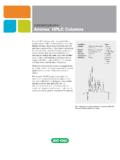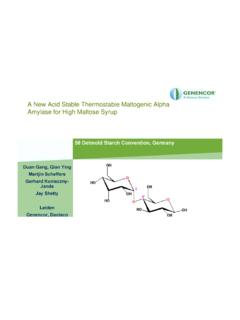Transcription of Development and optimization of a HPLC-RI …
1 Food Science and Technology ISSN 0101-2061. Development and optimization of a HPLC-RI method for the determination of major sugars in apple juice and evaluation of the effect of the ripening stage Ac cio Antonio Ferreira ZIELINSKI1, C ntia Maia BRAGA1, Ivo Mottin DEMIATE1*, Fl vio Lu s BELTRAME2, Alessandro NOGUEIRA1, Gilvan WOSIACKI1. Abstract The sugars in apple juice prove its authenticity and its sensory and nutritional properties. The aim of this study was to develop and validate a simple analytical method using high performance liquid chromatography with refractive index detection ( HPLC-RI ) to determinate and quantify the sugars sucrose, D-glucose, D-fructose, and D-sorbitol polyol in apple juices, as well as to analyze the juices from the Fuji Suprema and Lis Gala cultivars at three ripening stages. The analytical performance parameters evaluated indicated that the method was specific for the compounds analyzed, and the linearity of the calibration curves of sugars showed high correlation coefficients (close to ).
2 The limits of detection and quantification are consistent with recommendations available in the literature for this type of matrix. Sample preparation is simple and generates small amount of residues. Over 70% of the sugars were determined in the juices of apples at the pre-ripe stage, with an increase during senescence. This method is applicable for the determination of sugars in juices and evaluation of apple ripening. Keywords: Malus domestica; soluble carbohydrates; liquid chromatography; validation. 1 Introduction Apple, one of the most widely consumed fruits worldwide, (Llamas et al., 2011; Rodriguez-Saona et al., 2001), capillary is an important part of the human diet as a source of electrophoresis (Soga & Serwe, 2000), and gas chromatography monosaccharides, minerals, dietary fibers, biological active (GC) (Villamiel et al., 1998; Cerd n-Calero, 2012). Although gas compounds such as vitamin C, and phenolic compounds chromatography is a separation method with high sensitivity, that act as natural antioxidants (Wu et al.)
3 , 2007). Among the it requires time-consuming derivative stages, often using toxic temperate fruits grown in Brazil, it has shown the highest growth agents in the process. Moreover, high temperatures are required in terms of planted area and production volume over the last for analysis (Chinnici et al., 2005). twenty years. Most of the apple production is concentrated in Due to its simplicity, accuracy, and ease of sample the Southern region of Brazil, and the state of Santa Catarina preparation (involving only dilution and filtration stages is the largest producer, followed by Rio Grande do Sul and as pre-treatment of the sample), high performance liquid Paran . The apple varieties most commonly grown in Brazil are chromatography ( hplc ) has become popular because it of Gala' and Fuji' cultivars, which represent 55% and 40% of provides a rapid quantitative separation of the main sugars in production, respectively (Associa o Brasileira de Produtores fruit juices (Chinnici et al.)
4 , 2005; Lima et al., 2010). de Ma , 2007; Zielinski et al., 2012). In recent years, several researchers have emphasized the According to the Ministry of Agriculture, Livestock and use of the hplc technique for its high precision and analytical Supply, apple juice is defined as an unfermented and undiluted selectivity for the evaluation of diverse food components owing drink obtained from the edible part of the apple (Malus to its ability to determine and quantify these components in domestica B.) through appropriate technological processes . many different foods. Among the components determined (Brasil, 2009). using hplc are carbohydrates (Ch vez-Serv n et al., 2004;. Common adulteration of apple juice involves the addition Muir et al., 2009), organic acids (Chinnici et al., 2005; Lima et al., of water, sucrose, bagasse extract, or cheaper juices. Besides 2010), lipids (Puoci et al.
5 , 2008), vitamins (Speek et al., compromising the proof of authenticity, this also has an 1986; Rodriguez et al., 2012), colorants (Vidotti, et al., 2006;. effect on the sensory properties and nutritional value of Ma et al., 2006), amino acids and peptides (Zhang et al., 2010;. the apple products (Wu et al., 2007; Wosiacki et al., 2007). Garai-Ibade et al., 2012), mycotoxins (Kawashima & Soares, The major carbohydrates found in apple juice are the sugars 2006), and phenolic compounds (Shui & Leong, 2002; Acosta- sucrose, D-glucose, and D-fructose and the polyol, D-sorbitol Montoya et al., 2010), among others. (Wosiacki et al., 2007; Hecke et al., 2006). This study presents the Development and validation of an Several methods have been used for the determination of analytical method employing the HPLC-RI technique for the sugars in fruit and fruit juices, including spectrophotometry rapid and simultaneous determination of sucrose, D-glucose, Received 13 May, 2013.
6 Accepted 24 Nov., 2013 (006091). 1 Food Science and Technology Graduate Program, State University of Ponta Grossa UEPG, Ponta Grossa, PR, Brazil, e-mail: 2 Department of Pharmaceutical Sciences, State University of Ponta Grossa UEPG, Ponta Grossa, PR, Brazil *Corresponding author Food Sci. Technol, Campinas x analysis of sugars by HPLC-RI . D-fructose, and D-sorbitol in apple juice and to evaluate the maintained at 80 C and the detector at 50 C. Sample detection ripening stages of the apples of the Fuji Suprema and Lis Gala was performed by comparing retention times standards. cultivars. Method validation 2 Materials and methods Selectivity Materials The refractive index detector (RI) was used to identify the Ultra-purified water (type 1) obtained from Millipore compounds in Fuji Suprema and Lis Gala apple juice samples Milli-Q Integral system (Millipore, S o Paulo, Brazil) was harvested at different ripening stages.
7 The chromatographic used in all the experiments. The standards, sucrose, D-glucose, results were evaluated based of retention time and resolution for D-sorbitol, all with a purity exceeding , were purchased each analyte and compared with the retention time standards from Sigma Aldrich (Steinheim, Germany), and D-fructose of sucrose ( mg mL 1), D-glucose ( mg mL 1), D-fructose was purchased from Merck (Darmstadt, Germany). A Waters ( mg mL 1), and D-sorbitol ( mg mL 1). Sugar PakTM chromatographic column 1 (300 mm ). was used in the analyses. Linearity Samples Linearity was established by triplicate injections of seven (7). different concentrations of the standards obtained by dilution in Samples of Fuji Suprema and Lis Gala apples, 2012 harvest water of the mixture containing the four sucrose standards: season, were collected from the Ca ador Agricultural Research to mg mL 1; D-glucose, to mg mL 1; D-fructose, to and Rural Extension Company of Santa Catarina (EPAGRI, mg mL 1, and D-sorbitol, to mg mL 1.)
8 The calibration Santa Catarina, Brazil) at three different ripening stages (pre- curve for each sugar was obtained by plotting the concentration ripe, ripe, and senescent), with about 20 kg of samples for each of compound versus the area of the respective peaks. stage and each cultivar. The maturation index was determined by Lugol's starch test (Llorente et al., 2012). Limit of detection (LOD) and limit of quantification (LOQ). Apple juice processing The limit of detection (LOD) and the limit of quantification (LOQ) were determined by a method based on analytic curve The fruits were selected, cleaned, and then pureed using parameters, according to Equation 1 (Ag ncia Nacional de a food processor (Metvisa, Brusque SC, Brazil). The mashed Vigil ncia Sanit ria, 2003): fruit was wrapped in plastic sheets (with pre-punched holes). overlapping the layers and was subjected to a pressure of 3 kgf SD x SD x10.
9 LOD = LOQ = (1). cm 2 for 5 minutes (Eureka Hydraulic press, Hoppe Ind. Ltd., S o S S Paulo SP, Brazil). The juice was treated with pectinase (Pectinex . Ultra Clear, Novozymes, Arauc ria PR, Brazil) at a rate of 3 mL where: SD: standard deviation of the response; S: slope of the hL 1 (45 C, 2 h) (Wosiacki et al., 1989), and after pectinase analytical curve. sedimentation, the juice was poured into containers and frozen Precision Sample preparation The repeatability of the method was assessed by determining Samples of juice at different ripening stages were diluted the coefficient of variation (CV%) of the areas obtained from 1:10 (v/v) (Chinnici et al., 2005) with Milli-Q water (type 1) the injection of seven (7) replicates of the standard solutions and then filtered through a m filter membrane (Waters, (sucrose, mg mL 1, D-glucose, mg mL 1, D-fructose, Milford, MA, USA).)
10 An aliquot of mL of these solutions was mg mL 1 and D-sorbitol, mg mL 1) and of the juices placed in vials for the analysis . added to this mixture, respectively. In the evaluation of intermediate precision, three (3) replicates were used over Equipment and operating conditions three non-consecutive days (Ag ncia Nacional de Vigil ncia Sanit ria, 2003). The chromatographic system coupled to the refractive index detector ( HPLC-RI ) was equipped with a quaternary Accuracy pump (Waters 2695 Alliance, Milford MA, USA), degasser, auto injector, and Waters RI 2414 refractive index detector Accuracy was calculated by considering the recovery (Milford MA, USA), and the chromatographic data were obtained for each compound at different concentration levels acquired using the Empower 2 software. The samples obtained ( and mg mL 1 sucrose; and mg mL 1 D-glucose;. as described above were analyzed using an ion exchange column and mg mL 1 D-fructose; and mg mL 1.











